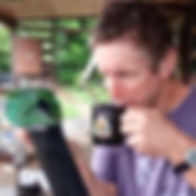About


The North Queensland Naturalist was first published in 1932 by the then newly formed North Queensland Naturalists Club (NQNC) and continued until the official closure of the club in 2002. Started by Dr Hugo Flecker of Flecker Botanic Gardens and Box Jellyfish (Chironex fleckeri) fame, the group documented its considerable activities related to the investigation and understanding of the natural history of the far north in this journal. The Cairns Historical Society and the National Library retain copies of this highly regarded journal.
The journal underwent a number of changes over time. It was published under the name North Queensland Naturalist from 1932 to 1992, however the volume numbering was dropped in 1982. After 1992 the name was changed to 'North Queensland Naturalists Club', then in 1999 became 'North Queensland Naturalists Club Cairns: Newsletter' until the closing of the club and journal/newsletter in 2002.
Many similar interest groups stemmed from the NQNC, and still persist in various guises – some of the original group still carry out field work, many Societies such as the Cape York Herpetological Society were borne out of NQNC and recently a North Queensland Natural History Group was formed. This group consists of people with a passion for the natural riches of north Queensland, ranging from interested members of the community to scientists and naturalists.
Discussions within the Natural History group focused on the need for a journal to:
-
document the natural values of the area;
-
to harness the large amount of observations, research and investigations taking place into the flora and fauna, natural history, conservation and land management of the region; and
-
to have the information all in one place so as to make it easier for interested parties to stay informed of work being done in the region by both amateurs and professionals.
History

An extract from NQN from 1969 – Volume 36 Number 149 featuring an article on North Queensland Coleoptera.

Edition 204, July to December 1997. The name and numbering system of the journal changed in 1994.
Editorial & Production

Dr Don Franklin
Don is a research ecologist, consultant and keen field naturalist based on the Atherton Tablelands, formerly based in Darwin, with particular interests in plants, vegetation and birds. He is an author of four books, twelve book chapters, and over 120 peer-reviewed papers and numerous popular science articles. He is, or has been, a subject editor for the journals Biodiversity & Conservation, Biotropica and Corella and production editor for the Northern Territory Naturalist, and for many years edited the newsletter Nature Territory.
Editorial

Adjunct Professor Peter Valentine
Peter Valentine is an Adjunct Professor at James Cook University. He worked mainly on conservation including protected area management when he was full time academic at the University and his research included biogeography and conservation of Australian butterflies amongst other areas. He has worked across the world and was Editor of the IUCN Best Practice Guidelines Series for the World Commission on Protected Areas for many years. While at James Cook University he was Head of the School of Tropical Environment Studies and Geography and also Head of the School of Earth and Environmental Sciences. He was an assessor for the Australian Research Council grants program and a referee for many journals both Australian and International. He has also been an examiner for PhD theses for several Australian Universities. His peer-reviewed publications number >100 and he was Chair of the Wet Tropics Management Authority until recently and a Director of Terrain NRM for 8 years. He is currently President of the Tree Kangaroo and Mammal Group and is Conservation Officer for Birdlife Northern Queensland.
Editorial

Dr Gabriel Crowley
Gay Crowley is an ecologist with over 30 years’ experience in research and extension aimed at improving environmental management. Her research interests span conservation ecology; biogeography; fire and biodiversity management; and Natural Resource Management planning. She has published extensively on the habitat and food requirements of threatened birds. Her current work involves combining legacy datasets with modern analytical techniques to understand the decline and recovery of the Endangered Golden-shouldered Parrot. She is a Vincent Serventy medallist, recognising her services to ornithology. She has been a handling editor for North Queensland Naturalist since 2017. Gay has authored or co-authored over 100 books, reports, plans, chapters, and peer-reviewed publications.
Editorial

Eric Vanderduys
Eric Vanderduys grew up in a few locations in southern and eastern Australia. He could never decide what was more interesting out of fish, reptiles, plants, birds or mammals. Then there's spiders and butterflies – it gets difficult to keep up. He saw a gap in the literature on the frog fauna of Queensland, which has more species of frogs than any other Australian state, and wrote Field Guide to the Frogs of Queensland, published in 2012. He worked on and off in northern Australia from 1995 onwards, before moving to north Queensland in 2003, where he took up a position as a field ecologist with the (then) Qld Environmental Protection Agency. In 2006 he moved across to CSIRO, still working as a field ecologist on a variety of landscape scale projects – mostly regarding the effects of fire, clearing, grazing and weeds on terrestrial vertebrates. Eric has published on reptiles, including describing new species from north Queensland (and there's more to come), amphibians, vertebrate ecology and mixed bird flocks. He orchestrated the rediscovery of the "extinct" lizard Lerista allanae from central Queensland in 2009. He has been a member of the Black-throated Finch Recovery Team since 2006, written about the endangered southern Blackthroated Finch, and maintains a database of records of this subspecies. He currently spends a lot of time catching and monitoring flying foxes, and trying to understand the ecology of feral pigs on Cape York Peninsula. He has reviewed papers on terrestrial reptile spatial ecology, bat and freshwater turtle ecology, invasive species, birds, geckos, snakes and frogs for a variety of journals such as Biological Conservation, Austral Ecology, Journal of Herpetology and Wildlife Research, as well as conducting numerous internal reviews for other CSIRO staff publications.
Editorial

Dr Ana C Palma
Ana Palma is a tropical ecologist interested in using science to understand the function of tropical ecosystems, our impacts on the environment and develop conservation strategies. Ana has experience designing, coordinating and conducting research projects in biodiversity and conservation in a range of tropical ecosystems. These projects have addressed critical research areas including plant-animal interactions, monitoring of threatened species, seed dispersal, seedling dynamics, impacts of forest fragmentation and tropical forest restoration. Ana has worked in Colombia, Peru, Ecuador and northern Australia. She moved to Cairns in 2012 to undertake her PhD studies and decided to stay in this beautiful part of the tropics. Ana has reviewed papers for different journals including, Applied Vegetation Science, Biological Reviews, Biotropica, Ecological Applications, Journal of Environmental Management and Restoration Ecology.
Production

Michael Anthony
Michael is retired from full-time work, currently employed seasonally as a tour guide into the Undara Lava Tubes. He has worked in a variety of occupations across northern Australia, including revegetation at Ranger Uranium Mines in the NT, furniture removals on Cape York, Torres Strait and Gulf Country and as a Wildlife Officer for Gulf Savannah NRM. Michael’s main interest is in reptiles and amphibians of tropical Australia and their distribution & habitat. In between paid work, Michael has been involved with herpetological societies and frog clubs for most of his life and presently involved with the North Queensland Natural History Group (NQNHG) and the Magnificent Brood Frog Working Group. He has contributed to a variety of publications, including Reptiles Magazine – the world's leading popular magazine about reptiles, Herpetofauna and Memoirs of the Queensland Museum. Michael edited, produced and wrote for Chondro, the Journal of the Cape York Herpetological Society from 1990 to 1998. Michael’s vision is that the various activities of the NQNHG and the papers published in the North Queensland Naturalist will inspire more people to appreciate nature and contribute towards its understanding and conservation.
Production

Linda Reinhold
Linda Reinhold studied terrestrial zoology and print journalism at UQ, with an Honours thesis on the taxonomy of bent-winged bats. She went on to work with microbats for several years, writing a world-first key to their echolocation calls. Swapping bats for numbats, Linda moved to Western Australia, initially working with Gilbert’s potoroos. She ended up as the ecologist on Project Eden for eight years, working with many wild and wonderful mammals and dabbling in herpetology. Working on the remote west coast involved both re-introducing native mammals to Project Eden (often radio-tracking them by small plane) and conducting fauna surveys on the islands of Shark Bay. She was an ambulance attendant in her spare time. In between mammal jobs, Linda spent some 28 seasons working with sea turtles, both in Australia and throughout the Caribbean. Since moving back to Queensland and settling in Cairns, Linda has mixed bushwalking with amateur mycology. An interest in glow-in-thedark fungi led her on night expeditions where she stumbled upon fluorescent mammals. This discovery led her to undertake Masters research on fluorescence in mammal fur. Linda has published a handful of scientific publications and popular articles. She was the newsletter editor of Science Queensland for The Royal Society of Queensland from 1999 to 2001. She has joined our team as a copy editor for the North Queensland Naturalist.
Production

Leanne Kruss
Having grown up on a remote sheep station, Leanne has always had a passion for land management, the remote wilderness and the required connection between farming, natural history and the environment. From a very early age, Leanne witnessed her family property win awards for environmental practises, with extensive work in animal corridor plantations, wildlife surveys and regenerative agriculture practises, including the planting of legumes for soil rejuvenation and native tree plantings in riparian zones, and zones of significance. Leanne won a scholarship to study a science degree in Sweden, and majored in arid wilderness landscapes, her true love, and spent extensive time in the remote northern parts of Sweden in the artic rim. She has also gained qualifications in chemistry, teaching and wildlife rehabilitation, and is currently studying Agrifood systems and technology. Leanne is Far North Queensland Workforce Development Officer for agriculture. Her role is to initiate and collaborate opportunities to progress agricultural development, especially within the people. She helps provide the ability for rural regions to be competitive, resilient and responsive to future challenges and to develop capacity and capability, enabling them to lay a foundation for sustainable growth and long term prosperity. She sees this as the perfect platform to educate, upskill and encourage the cultivation of new networks to encourage conversation, concern and build trust regarding the well-being of our diverse flora and fauna and our need as a nation to unite in the preservation of all species. She has recently won the Queensland Regional, Rural and Remote Strong Women Leadership Award for 2015. She has also developed a Natural Science Award and Bursary for a student of excellence in Year 12 Far North Queensland that is beginning tertiary studies in the area of Natural Science. Leanne understands the power of connection. She sees herself as the interface between the scientists and the people of the land. She sees the advancement of rural networks with sharing of knowledge, mentoring, information and passion as insurmountable in equipping land managers with valuable tools, of feeling empowered and esteemed and enhancing joint decision making through collaboration of productive partnerships with the natural world and family farming. Anything we can do for our wilderness areas, for all of our incredible creatures and in educating people is what truly matters to Leanne. She is extremely motivated when needed, from both human and animals. In her “spare” time between work and land manager, Leanne is a wildlife rescuer and rehabilitator and releases native species back into the wild upon recovery. She is on the executive for Tablelands Wildlife Rescue Inc., and also a member of the Queensland and National Wildlife Rehabilitation Councils. She loves nothing more than to infect others with her passion for life and the Australian outback. Because of her extensive years working in schools, Leanne is also really attached to getting families into the outdoors to care about nature, love the environment, and be fascinated by the wildlife and to commit themselves to be more responsible in their life choices. She is highly skilled in the teaching of minimal impact techniques and is often found leading “at risk” students on remote hiking and caving expeditions on a purely volunteer role. She believes passionate people are more fully engaged in life and will create purpose far greater than themselves.
Production

Amy Shima
Amy is a wildlife veterinarian based on the Atherton Tablelands. She has numerous publications on various aspects of wildlife medicine and recently completed a PhD on Lumholtz’s Tree-kangaroo (Dendrolagus lumholtzi). She is interested not only in the health of animals but also in their use of habitat and the roles they play in the ecosystem of far north Queensland. Her current research interests center around koalas in far north Queensland but remains interested in other arboreal folivores, especially tree-kangaroos.
Production

Dr Dermot Smyth
Dermot describes himself as a lapsed zoologist. A research project on echolocation in Australian Swiftlets in the 1970s included a trip to Cape York Peninsula and his first encounters with Traditional Owners and their connection to Country. It was an experience that led to Dermot’s 40-year involvement in supporting Aboriginal and Torres Strait Islander peoples’ involvement in managing their traditional land and sea environments. Working with Indigenous organisations, conservation agencies, universities and as a private consultant, Dermot contributed to Indigenous Ranger training, establishment of Indigenous Protected Areas (IPAs), and Indigenous-led Country-based planning across Australia. In retirement, Dermot has enjoyed reconnecting with Australian Swiftlet colonies on North Queensland’s Family Islands, which now form part of an innovative terrestrial and marine IPA. Dermot has published widely in journals, edited two books and written way too many consultant’s reports; he has joined the North Queensland Naturalist team as a copy editor.
Communications

Renée Cassels
Renée is an experienced marketing professional and graphic designer. Scientifically trained as an ecologist, but drawn to the creative industries, Renée is now actively involved in conservation volunteering while working in the creative sector in service of organisations with shared vision and values. Her Honours Thesis focussed on the effects of habitat fragmentation on the Pale-yellow Robin across the Atherton Tablelands.
